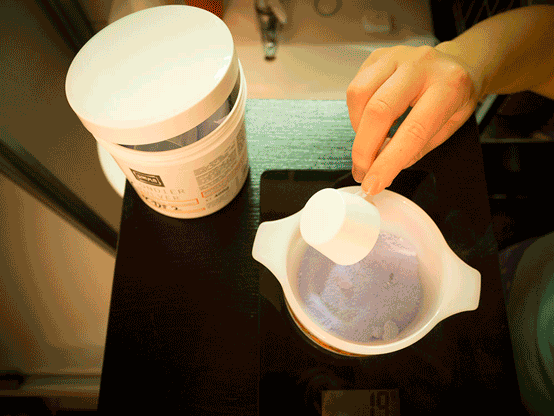Too many words! I want to start!
You need a bowl, a hair dye brush, a kitchen scale, and protective gloves. Read the instructions on the packaging, and be careful to not get any of those chemicals into your eyes. I have a glass bowl that I always use for my hair products, and I use plastic hair dye brushes (Along with some smaller painting brushes for details). You can use whatever you want as long as nothing used to mix and apply your bleach has any metal components – metal can interfere with the chemical reaction. As this is most convenient, I usually mix my bleach by weight.
Stains and Spilling: Prepare your working area before getting any of the chemicals out. The bleach tends to spill and splatter around, so do it somewhere this isn’t going to cause a problem. It’s probably obvious, but don’t wear anything you do not want to get bleach stains on either.
Now mix your bleach:
Bleaching supplies.
I buy the basics in bulk, so I have big bottles in all the volumes, and big boxes of bleaching powder – you will probably get smaller packages but the basic idea is the same.
The example “recipe” here is for 60g of bleach, because this is how much I usually make to bleach roots, which is what happens most often. If I only have a month of growth, 50g are usually enough. If the hair hasn’t been bleached in 2 or 3 months you will need more, but don’t worry too much. It’s very easy to just mix more bleach when running out. When bleaching a whole head of hair, you have do adjust the amounts accordingly. Short hair usually doesn’t really need more bleach than a roots-only treatment, but bleaching longer hair can use up a lot of product.
This is how I mix my bleach
(if you are using a different product follow the instructions it comes with):
- Put your bowl on the scale and turn the scale on;
- Pour two parts peroxide cream in your bowl (here that’s 40g);
- Carefully add bleaching powder (here, that’s 20g);
- Mix the two components together slowly. The powder is really hard to contain, so please be careful;
- Mix until it’s a homogenous paste;
- Now the reaction has started and it will be bleaching for about an hour or so. The bleach paste starts to puff up a bit at some point, and this is what it is supposed to do.
And that’s how the bleach mixture looks when it’s ready to use.
The first step after mixing is to apply your bleach to the roots. Try to really only bleach the roots, as bleaching your hair more times than absolutely necessary really just damages it. If you only need to bleach your roots, you can skip the next part and put on your shower cap now.
A little tip: bleaching the roots once a month (and not only every 3 when there is a lot of new growth) is actually much easier.
Applying the bleach to my roots.
For the second step, after the roots are done, you work the goo into the rest of your hair. Make sure that the hairline and all the edges are covered with enough bleach it won’t dry out too early.
There are plenty videos on how to apply hair dye or bleach, so I won’t explain this part here in great detail. You start with dry or damp hair: Some brands come with specific instructions, others do not. I generally put the bleach on dry hair, but I always dye it whilst still damp.
That’s what it looks like with the bleach in. Not very spectacular.
Shower cap!
Then put on your shower cap and just wait until your hair is as light as you want it – or until the bleach stops working. Check your product’s instructions for exact times. After that, thoroughly rinse and shampoo your hair. If you want to dye it right away, you can do that – in this case better use some silicone-free shampoo to rinse out the dye. If you don’t, now is the time for conditioner and/or a hair mask.
That’s how my hair looks after rinsing.
Troubleshooting/Things to watch out for
If you want to bleach more than just the roots (usually you would only want to do that if your hair is not bleached at all yet, or if it is dyed already), I suggest mixing the bleach in batches to make sure you have enough time to apply it. Properly adding bleach to the roots takes a while in the beginning, so do that before you mix the bleach for then lengths. Again, short hair is the exception: You can just mash the bleach in like you would do with shampoo.
There are two things you really need to know about bleach before starting: It only works as long as it is wet, and heat boosts the process.
Keeping the Hair Moist:
This is especially problematic with short hair. If you have really short hair, it will likely dry up before the peroxide has done it’s magic. But even if you have long hair, the tiny hair around your face and where your hair is parted tend to dry out before it’s done. The best solution for this problem seems to be a reusable shower cap – tinfoil or saran wrap work too, but they tend to tear, and move, and make the worst crinkly noises. They also tend to come off at the edges, which is where you need them most.
If the edges dry out early, that’s what happens. We did it on purpose for this tutorial, but you can get dry spots everywhere along your hairline
Keeping it Warm:
Shower cap! Put it on after applying the bleach to trap body heat. This is mostly relevant for really dark hair that is hard to bleach to begin with. But generally it is just a good idea to put on a shower cap to keep the bleach contained underneath it, and not have it dry out prematurely. But do not use a hair dryer or other external sources of heat at this point.
Tadaaa. This will solve almost all of your problems.














